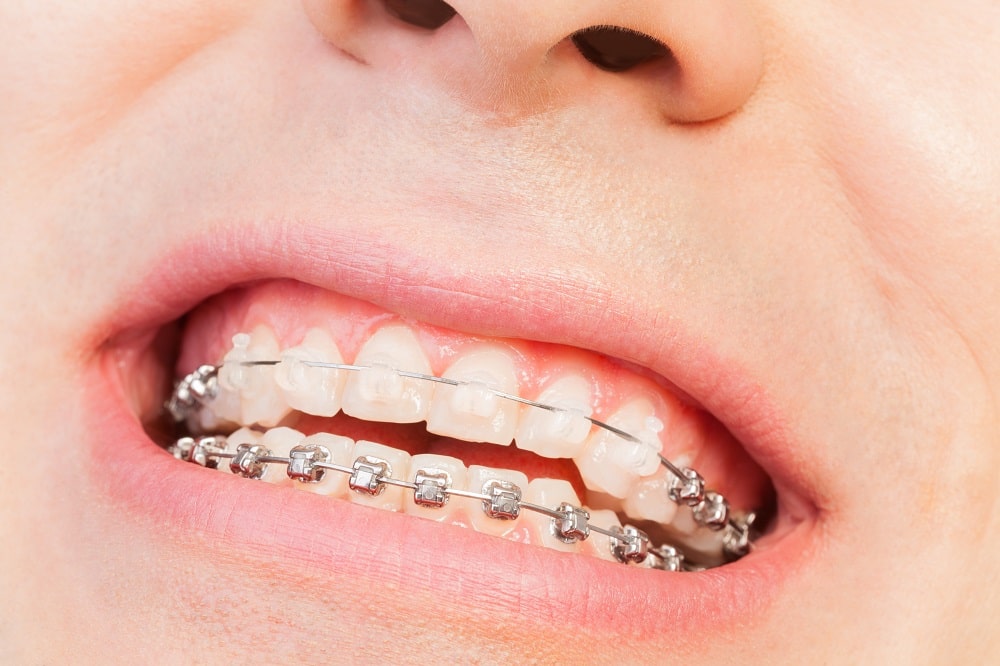
A crossbite is a dental condition where some of the upper teeth sit inside the lower teeth when the mouth is closed. This misalignment can affect a single tooth or a group of teeth and can occur at the front (anterior crossbite) or the sides (posterior crossbite) of the mouth. Crossbites are usually caused by a misalignment of the teeth or a discrepancy in the size or position of the upper and lower jaws. They can lead to uneven wear of the teeth, gum disease, and jaw problems like temporomandibular joint disorder (TMJ). Treatment typically involves orthodontic procedures, such as braces or clear aligners, and sometimes dental or orthognathic surgery for more severe cases.

The number of involved teeth, their position and their location in the mouth determine the classification of a crossbite. The different types of crossbite include:
An anterior crossbite is also called an underbite. This condition affects the front teeth causing the upper teeth to rest behind the lower teeth in the front. Different factors such overcrowded teeth or a jaw size discrepancy can cause this crossbite.
This crossbite is visible, causing a forward chin projection or making the jaw look uneven.
A posterior crossbite affects the back teeth. The upper teeth sit inside the bottom teeth instead of resting over the top of the bottom teeth. The factors that cause an underbite are also responsible for a posterior crossbite. The baby teeth falling out late, the eruption of permanent teeth in the wrong position or a jaw asymmetry can cause this condition.
These two definitions relate to the position of the teeth in relation to each other when they meet. Your orthodontist will show you what this looks like if you have a crossbite or if your child has a crossbite. People with either of these crossbites often feel a lot of the biting surface of their inner teeth when they close their mouths.
In a bilateral crossbite, the crossbite affects both sides of the mouth. However, the crossbite only affects one side of the mouth in a unilateral crossbite. The treatment for these conditions are similar, but the technique may differ slightly.
A single-tooth crossbite is a crossbite affecting only one tooth. It may result from excessive projection of a bottom tooth, usually one of the canine or front teeth, or when a top tooth is pushed towards the inside of the mouth.
For s segmental crossbite, a few teeth do not line up. It often affects two or three teeth in a row.
| Type of crossbite | Description |
|---|---|
| Anterior | Affect the front teeth |
| Posterior | Affect the back teeth. |
| Buccal | The lower teeth project towards the cheek |
| Lingual | The lower teeth project towards the tongue |
| Bilateral | Affects both sides of the mouth |
| Unilateral | Affects one side of the mouth |
| Single-tooth | Affect only one tooth |
| Segmental | Affect 2 or more teeth in a row |
While crossbites have different descriptions, their treatment options are usually similar. The best time to treat crossbites is in childhood. The teeth and bones are easy to move at this stage because growth and bone development is still taking place.
Research shows that treating crossbite in childhood gives an 80% likelihood of successful treatment without requiring other solutions.
Orthodontic treatment on the upper and lower teeth is a common solution for anterior and posterior crossbites. The orthodontist may also recommend a palate expander during the braces treatment. The palate expander helps expand the upper jaw to allow the upper teeth to align and meet more evenly with the lower teeth in the lower jaw.
The orthodontist will adjust the palate expander throughout the treatment, and the teeth in the upper jaw will gradually expand apart.
Further teeth straightening may be needed when the palate has expanded to the correct size. Different types of braces are available for this. After the orthodontic treatment, retainers are necessary.
For those who prefer to avoid metal fixed braces they can opt for other reliable orthodontic treatment options like Invisalign aligners or clear braces.
Treatments besides metal braces are only available in private practices.
Clear aligners can correct mild to moderate crossbites. Invisalign offers some benefits over metal braces as they are virtually invisible, and patients can remove them for upto 4 hours daily.
Elastics can treat crossbites at the back of the mouth. During this treatment, the orthodontist will fix a small bracket or button to the inside of the top tooth and the outside of the bottom tooth, then connect them with an elastic band.
The procedure aims to pull the top tooth outwards to sit over the lower teeth in the correct position. It is a simple process that takes a few months to correct.
Severe cases of a crossbite require surgery, and this procedure is quite common. The public NHS covers the cost involved in jaw realignment surgery for those under the age of 18 years. Before crossbite surgery, the patients undergo braces treatment for 12 – 18 months and wisdom teeth extraction, if necessary. These processes are necessary to realign asymmetric jaws at the back of the mouth.
During the jaw realignment surgery, the surgeon will surgically section the jaw and place it in the ideal position then hold the jaw in place with titanium plates and screws. There is no visible scarring following this procedure because the incisions are inside the mouth.
Recovery after surgery takes 6 – 12 weeks with the need for 4 weeks off work and 6-12 months of further orthodontic treatment is then required to settle the new bite into place. If you feel anxious about the outcome of crossbite surgery, ask your orthodontist and maxillofacial surgeon for before and after photos of people who have undergone a similar procedure.
Crossbite treatment is usually carried out during childhood, and may be available within the NHS. However, when jaw realignment is needed then the orthodontist will wait for the child to grow before then discussuing jaw realignment surgery.
Adults can still have uncorrected bilateral or unilateral crossbites. Consult your orthodontist to determine the most suitable treatment options for your case.
The cost of surgical orthodontics and jaw surgery varies depending on the severity of the case and the treatment needed. Consult your orthodontist for more information regarding this.
A crossbite may not look serious, but it can cause further problems if left untreated. Anterior and posterior crossbite are linked to many issues, such as:
It is never too late to straighten your teeth and enhance your smile. The treatment options above are available to adults. Most adults prefer clear braces, lingual braces or Invisalign aligners to reduce the visual impact of having braces.
If you or your child has a crossbite, our orthodontists at Kingston Orthodontics will offer suitable treatment options tailored to your needs. Visit us today or call 0203 002 2501 to book an appointment with our orthodontists.

Spread the cost of any treatment
We are here to help you achieve the perfect – and affordable – smile so please talk to us about our popular interest-free payment plans. Spread the cost and relax – secure in the knowledge that your treatment will take place on time and on budget.